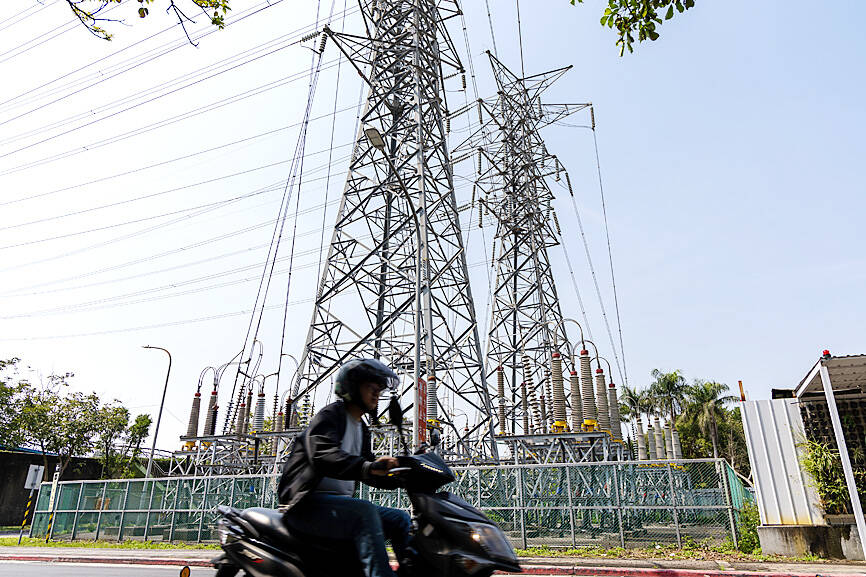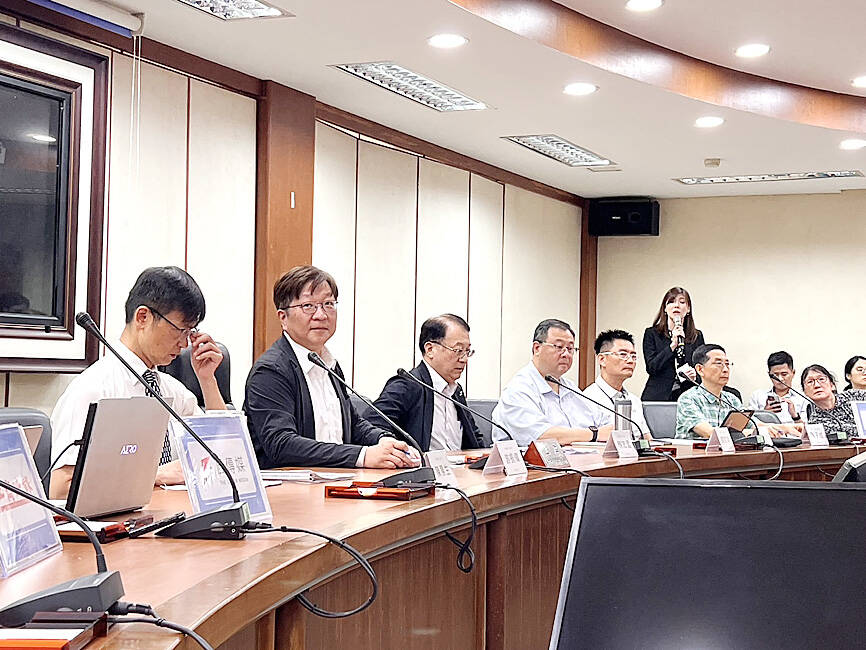Taiwan’s power consumption is to increase faster at an annual compound growth rate of 2.5 percent over the next five years, mainly driven by an eightfold surge in electricity usage by artificial intelligence (AI) applications, the Energy Administration said yesterday.
The latest forecast represented an increase from the 2 percent growth estimated last year for the period from last year through 2029.
The annual growth rate from this year to 2033 is expected to reach 2.8 percent as new data centers for AI applications become operational, the administration said in a report.

Photo: CNA
The increase in demand comes as Taiwan is expected to undergo a strong economic recovery this year, the semiconductor industry expands capacity amid an AI boom and electric vehicles become more popular, the report said.
AI applications including AI-focused data centers would consume about 2.24 gigawatts (GW) of power in 2028, expanding eightfold from 240 megawatts last year, the administration said.
The latest forecast factored in the expected deployment of new data centers, likely from Apple Inc, Nvidia Corp and Amazon Web Services, in addition to existing centers operated by Google, Microsoft Corp and Nvidia.

Photo: Lin Jin-hua, Taipei Times
“Because of AI, Taiwan has to add 12 to 13 percent more capacity during peak load during the 2024-2029 period,” Energy Administration Director-General Yu Cheng-wei (游振偉) told a news conference in Taipei yesterday.
The administration identified this year to 2028 as the critical period when electricity consumption would spike due to rapid uptakes of AI data centers, large-language AI training models and supercomputer centers, which have not been included in the administration’s forecast before.
Peak load demand is expected to expand to about 4.21GW at night from 3.73GW this year, the administration said.
To ensure stable and sufficient supply, Taiwan Power Co (Taipower, 台電) would install more natural-gas generators, enhance electricity grid resilience by revamping electrical substations and expand green energy storage systems, Yu said.
He urged the public to support CPC Corp, Taiwan’s (台灣中油) deployments of new liquefied natural gas (LNG) terminals to regasify LNG before sending it to power stations.
The construction of new LNG terminals was suspended amid environmental concerns.
Taipower projected its reserve margin would improve to 13.3 percent in 2028 from 8.5 percent this year.
That figure is expected to climb to 23.8 percent in 2033, indicating that its electricity capacity would outgrow demand, or capacity adequacy, the state-run utility said.
Asked if the administration would consider restarting or delaying the shutdown of nuclear power plants, Yu said the administration would respect the legislature’s decision on the matter.
Renewable energy is to account for 20 percent of the total power supply in November 2026, rather than the government’s 2025 target, the third time the government has pushed back the goal.
Yu blamed a surge in power consumption for the delays, but said the deployment of renewable energy generation remains on track.
By the end of 2029, green energy is projected to make up about 25 percent of the total power supply, down from 27 percent estimated last year, largely due to increases in total power supply, the report said.

Nvidia Corp chief executive officer Jensen Huang (黃仁勳) on Monday introduced the company’s latest supercomputer platform, featuring six new chips made by Taiwan Semiconductor Manufacturing Co (TSMC, 台積電), saying that it is now “in full production.” “If Vera Rubin is going to be in time for this year, it must be in production by now, and so, today I can tell you that Vera Rubin is in full production,” Huang said during his keynote speech at CES in Las Vegas. The rollout of six concurrent chips for Vera Rubin — the company’s next-generation artificial intelligence (AI) computing platform — marks a strategic

REVENUE PERFORMANCE: Cloud and network products, and electronic components saw strong increases, while smart consumer electronics and computing products fell Hon Hai Precision Industry Co (鴻海精密) yesterday posted 26.51 percent quarterly growth in revenue for last quarter to NT$2.6 trillion (US$82.44 billion), the strongest on record for the period and above expectations, but the company forecast a slight revenue dip this quarter due to seasonal factors. On an annual basis, revenue last quarter grew 22.07 percent, the company said. Analysts on average estimated about NT$2.4 trillion increase. Hon Hai, which assembles servers for Nvidia Corp and iPhones for Apple Inc, is expanding its capacity in the US, adding artificial intelligence (AI) server production in Wisconsin and Texas, where it operates established campuses. This

US President Donald Trump on Friday blocked US photonics firm HieFo Corp’s US$3 million acquisition of assets in New Jersey-based aerospace and defense specialist Emcore Corp, citing national security and China-related concerns. In an order released by the White House, Trump said HieFo was “controlled by a citizen of the People’s Republic of China” and that its 2024 acquisition of Emcore’s businesses led the US president to believe that it might “take action that threatens to impair the national security of the United States.” The order did not name the person or detail Trump’s concerns. “The Transaction is hereby prohibited,”

Garment maker Makalot Industrial Co (聚陽) yesterday reported lower-than-expected fourth-quarter revenue of NT$7.93 billion (US$251.44 million), down 9.48 percent from NT$8.76 billion a year earlier. On a quarterly basis, revenue fell 10.83 percent from NT$8.89 billion, company data showed. The figure was also lower than market expectations of NT$8.05 billion, according to data compiled by Yuanta Securities Investment and Consulting Co (元大投顧), which had projected NT$8.22 billion. Makalot’s revenue this quarter would likely increase by a mid-teens percentage as the industry is entering its high season, Yuanta said. Overall, Makalot’s revenue last year totaled NT$34.43 billion, down 3.08 percent from its record NT$35.52